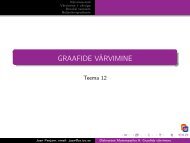Reactive Systems: Modelling, Specification and Verification - Cs.ioc.ee
Reactive Systems: Modelling, Specification and Verification - Cs.ioc.ee
Reactive Systems: Modelling, Specification and Verification - Cs.ioc.ee
Create successful ePaper yourself
Turn your PDF publications into a flip-book with our unique Google optimized e-Paper software.
78 CHAPTER 3.5. GAME CHARACTERIZATION OF BISIMILARITY<br />
We will define attacker’s universal winning strategy from (s, t) <strong>and</strong> hence show<br />
that s ∼ t.<br />
In the first round the attacker plays on the left-h<strong>and</strong> side the move s a → s1<br />
<strong>and</strong> the defender can only answer by t a → t1. The current configuration becomes<br />
(s1, t1). In the second round the attacker plays on the right-h<strong>and</strong> side according<br />
b<br />
b<br />
to the transition t1 → t1 <strong>and</strong> the defender can only answer by s1 → s3. The<br />
current configuration becomes (s3, t1). Now the attacker wins by playing again<br />
the transition t1 b → t1 (or t1 b → t2) <strong>and</strong> the defender loses because s3 .<br />
Exercise 3.37 Consider the following labelled transition system.<br />
a<br />
s <br />
<br />
s1<br />
b<br />
<br />
s2<br />
b<br />
a<br />
a<br />
t<br />
<br />
b <br />
t1<br />
b<br />
<br />
<br />
t2<br />
a<br />
a<br />
<br />
u<br />
a<br />
a<br />
<br />
u1 u2 <br />
<br />
b<br />
<br />
<br />
b <br />
b<br />
<br />
<br />
<br />
u3<br />
a<br />
v <br />
a<br />
<br />
b<br />
v1 <br />
v2 <br />
<br />
<br />
b <br />
b<br />
<br />
<br />
<br />
v3<br />
Decide whether s ∼ t, s ∼ u, <strong>and</strong> s ∼ v. Support your claims by giving a universal<br />
winning strategy either for the attacker (in the negative case) or the defender (in<br />
the positive case). In the positive case, you should also define a strong bisimulation<br />
relating the pair of processes in question. <br />
Exercise 3.38 (For the theoretically minded) Prove Proposition 3.3 on page 75.<br />
Hint: Argue that, using the universal winning strategy for the defender, you can<br />
find a strong bisimulation, <strong>and</strong> conversely that, given a strong bisimulation, you<br />
can define a universal winning strategy for the defender. <br />
Exercise 3.39 (For the theoretically minded) Recall from Exercise 3.17 that a<br />
binary relation R over the set of states of an LTS is a simulation iff whenever<br />
s1 R s2 <strong>and</strong> a is an action then<br />
• if s1 a → s ′ 1 , then there is a transition s2 a → s ′ 2 such that s′ 1 R s′ 2 .<br />
A binary relation R over the set of states of an LTS is a 2-nested simulation iff R<br />
is a simulation <strong>and</strong> moreover R −1 ⊆ R.<br />
b
















